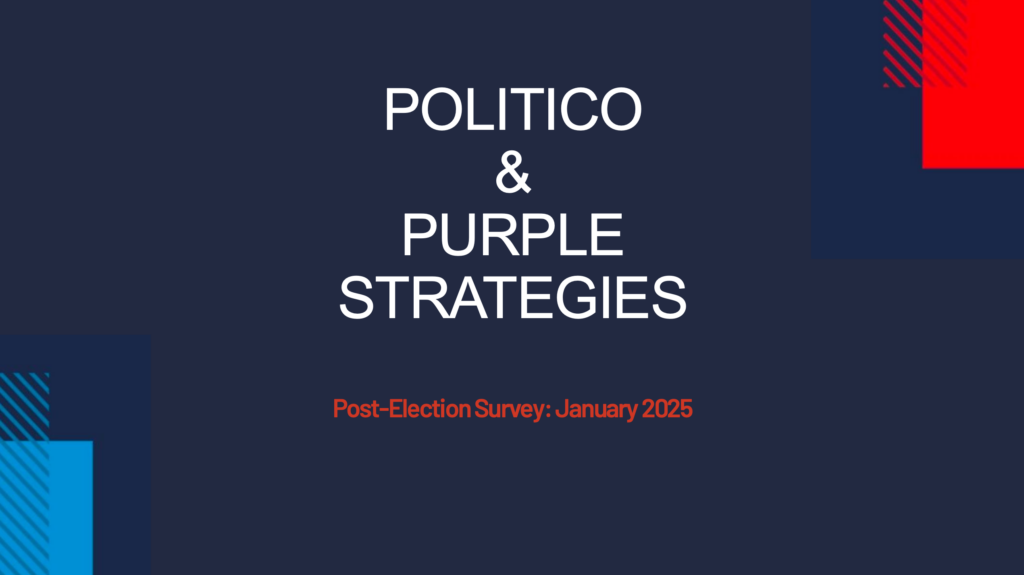Uncategorized

Posted on
May 1, 2025
6 Min. Read
Author
Purple Strategies
Waiting to Engage in D.C. Is the Most Expensive Mistake You’ll Make
By: Chris Durlak
Straight to the Point
- A company’s success can put a target on its back — the smart ones show up in D.C. and engage with policymakers and regulators before they’re in the crosshairs.
- Waiting until you’re under fire to engage can be a costly mistake that could mean the narrative’s already written, and it wasn’t written by you.
- Corporate leaders should look to engage early, pick their battles, and make sure Washington hears their story before someone else tells it.
What We See

Success can make you a target. In those golden years of rapid growth — when the headlines are glowing, and the public loves your product — it’s easy to believe your company is untouchable. But that’s exactly when policymakers and regulators in Washington start watching.
This year, Microsoft, one of the world’s most valuable and recognized brands, is celebrating the 50th anniversary of its founding. Bill Gates recently reflected on the company’s early days and discussed one of his biggest regrets: “I was pretty naive about not engaging in Washington, D.C. as soon as I should have.”
After a high-profile antitrust battle, Microsoft shifted course — dramatically. They invested early in rebuilding trust, embraced smart regulation, and worked to become known as the “reasonable” tech company in Washington, compared to industry competitors. That early engagement later paid off in goodwill, credibility, and better policy outcomes, even as their peers faced headwinds.
They’re not alone. Other high-profile examples include:
- Google, watching what happened to Microsoft, wasted no time embedding itself in Washington. It opened a D.C. office early, built relationships on both sides of the aisle, and funded think tanks and research to help shape policy debates on issues impacting the company. For over a decade, that early investment bought Google time, influence, and insulation from major U.S. regulatory action.
- T-Mobile, facing tough antitrust odds on its merger with Sprint, launched an early charm offensive in Washington — defining the narrative and shaping the terms of approval before critics could effectively mobilize.
- The auto industry, staring down climate policy and emissions mandates, chose to collaborate with regulators instead of fighting them — leading to one national standard that gave them regulatory certainty and reputational credit.
These companies understood that Washington isn’t just where problems are solved, it’s where narratives are written. And by showing up early, they were able to help write their own story.
What it Means
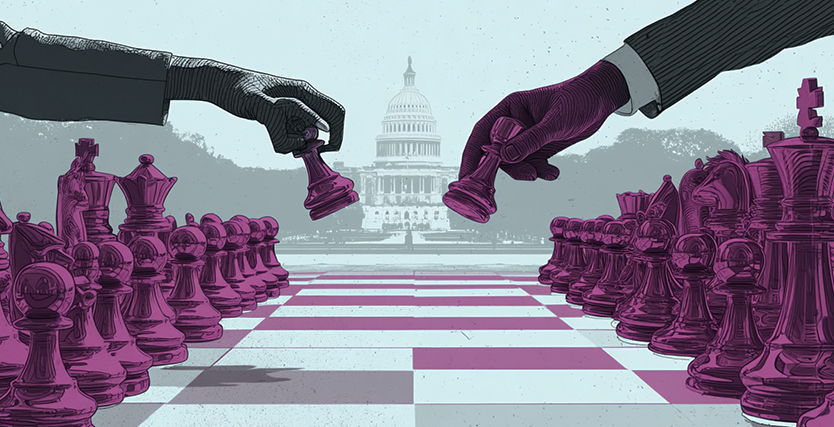
Late engagement in Washington is like trying to make friends in the middle of a fight. By the time scrutiny hits, alliances have formed, public opinion has hardened, and narratives are being written without you. Rebuilding trust at that point becomes harder, slower, and far more expensive.
Early engagement is not about self-congratulation or operating in crisis mode prematurely — it’s about risk management, influence building, and long-term resilience. It means shaping the conversation before your company’s name ever comes up.
Early engagement also doesn’t just mean hiring a lobbyist or opening a D.C. office. That’s table stakes, and it’s been that way since the ’80s. Today, real engagement means understanding the political landscape, defining a clear policy agenda, and aligning your company’s voice, values, platform, and reputation to support it.
What to Do About It

To avoid playing defense later, companies need to make intentional, early decisions now that shape how they’re seen and heard in Washington.
Start Before the Storm: Invest in engagement when the sky is clear, not when the storm hits. That means building your D.C. profile and your reputation in parallel with your business success. When companies wait until they’re under fire, they’re usually left playing defense.
Define Your Platform: Are you just another name on an industry association list, or are you known in D.C. for something specific — something that aligns with the politics of the moment? Many companies rely too heavily on outside voices. While a necessary lever in Washington, these associations support the interests of the collective, not the company. Sometimes you need your own voice.
Define Your Policy Agenda: What do you stand for in Washington? What do you quietly hope never happens? Being clear on both gives you the strategic edge to act early, not react late.
Reputation is the First Tool: Reputation is more than visibility — it’s the foundation of trust and the license to lead. In Washington, if you’re not known for something meaningful, you’re just noise — or worse, a blank slate others are eager to fill.
Match the Moment: Today’s policymaking is driven by populist pressures, regulatory activism, and rising demands for companies to take a stand on societal issues. This isn’t your daddy’s Oldsmobile: the old alliances are gone, and Republicans aren’t reflexively pro-business anymore. They rose to power on a populist wave — and they’re more focused on punishing elites than protecting them. Your policy approach needs to meet these new realities and adapt to an ever-changing political environment.
Engaging effectively in D.C. is not about checking every box — it’s about making deliberate moves that reflect where your business is going and what’s coming next. Get those moves right, and Washington becomes a partner, not a problem.
The Purple team has helped some of the world’s most well-known organizations navigate critical business challenges and engage in Washington. If you need support, contact us — we are here to help.
For more content like this, subscribe to the Purple Point newsletter here.

Posted on
April 10, 2025
8 Min. Read
Author
Purple Strategies
The Era of High-Stakes Uncertainty
The expansion of executive power has unleashed an era of high-stakes uncertainty. Businesses should plan accordingly.
By: Josh Weisz
Straight to the Point
What We See: The escalating expansion of executive powers of the modern presidency is creating unprecedented uncertainty for every industry in every corner of the world. Less than three months into the new administration, law firms, institutions of higher education, media companies, and other organizations — large and small — have experienced sudden and, at times, existential challenges stemming from executive actions.
What It Means: Businesses should be thinking less about if they will cross paths with the administration, and more about when and how. The old playbook — wait, lobby quietly, count on predictability — doesn’t cut it anymore. The rules have changed. Fast.
What to Do About It: While there is no one-size-fits-all approach to navigate today’s political climate and business challenges, every organization should be taking action to mitigate risk and protect their license to operate.
What We See

The era of slow government is over. An era of high-stakes uncertainty is just beginning. After years of escalating gridlock and deference, Congress is no longer setting the agenda. The days of deliberation, negotiation, and delay on Capitol Hill have been replaced by swift executive action.
Today, we’re watching a presidency that doesn’t wait. Major decisions — on trade, education, federal spending, and everywhere else — are made (and unmade) every day. A single executive order, speech, or social post can swing markets, upend industries, or create existential risk for companies overnight.
The past week of seismic tariff activity is just the latest example. The escalating expansion of executive powers is creating unprecedented uncertainty for every company in every corner of the world.
Trade policy is the most visible and impactful example, but it is merely the very sharp tip of a very large iceberg. Less than three months into the new administration, law firms, institutions of higher education, media companies, and other organizations — large and small — have experienced sudden and, at times, existential challenges stemming from executive actions.=
What worked in the past — quiet lobbying, waiting for the right moment, assuming predictability — may not work anymore. The rules of engagement are changing. Fast.
What it Means

Businesses should be thinking less about if they will cross paths with the administration, and more about when and how. Executive branch issues come in many shapes and sizes, but they consistently present three major challenges.
- Attention and outrage are spread thin: The speed and volume of the White House’s activity has confounded political opponents for more than a decade. The same “flood the zone” approach is a challenge for organizations looking to corral attention and build momentum. By the time a company develops its response, media and stakeholder energy has shifted to the next headline.
- Negative partisanship is powerful: Companies seeking to push back on an executive action may find that amplifying opposition to the action from certain voices is ultimately counterproductive.
- Allies may be reluctant: There is a strong incentive for companies that are not directly impacted by an executive action to avoid getting involved, particularly if they have existing political capital or partnerships with the administration. Organizations facing existential challenges may find that their usual defenders are less vocal.
What to Do About It

Finding an Antidote to Uncertainty
Every organization should be taking deliberate steps to protect its license to operate in today’s volatile environment. Companies must pressure test assumptions, reexamine stakeholder priorities, and build decision-making muscle for moments when speed and clarity matter most. There is no one-size-fits-all playbook, but there are smart, proactive actions that can help companies stay ahead of risk, respond with confidence, and position themselves for resilience — no matter what comes next.
1. Locate Your Emergency Exits
In moments of conflict with the administration, some organizations have solved existential risks by taking actions that relieve pressure, while others have stood firm and turned to powerful stakeholders and the legal system. Now is the time for companies to assess potential scenarios, align on an approach, and identify actions they would be willing to take. Waiting to make these decisions until crisis hits can allow panic to replace strategy while robbing communications teams of valuable time to formulate messages for internal and external stakeholders.
2. Make New Friends, Open New Doors
The steady collapse of bipartisanship in Washington has created not just information silos but influence silos as well. Particularly in an era of one-party control, stakeholders outside the governing coalition have little or no direct influence on policymaking — but the cyclical nature of today’s politics means voices across the political spectrum are always one election away from becoming critical influencers.
Companies must be intentional and diligent in understanding areas of common ground with a broader range of influencers and developing a more well-rounded group of allies. They must be equally focused on cultivating a diverse bench of internal voices as well.
3. Treat Employees as Adults
In the face of sustained political and economic instability, employees have generally become more pragmatic about the actions leaders must take to defend and grow the business. Companies should be proactive and transparent about articulating their approach internally, highlighting their responsibility to employees, customers, investors, and other key stakeholders. Internal communications can also provide a valuable platform to deliver authentic messages to external stakeholders.
4. Words Matter
Sustainability reports, internal employee initiatives, and other company content that may have been perceived as benign six months ago could cause unnecessary risk today. Companies should take time to review existing language and leverage diverse perspectives to identify potential potholes without compromising core values or business strategy. This is particularly important for organizations conducting advocacy campaigns that may draw increased attention and scrutiny.
5. Remember That Today’s Action Will Be Judged in Tomorrow’s Context
Certain scenarios do not afford companies the luxury of long-term thinking but, in most instances, companies are better served by thinking beyond the current moment. The quickest route out of a crisis is not always the best decision for the company long-term, and while more nuanced approaches involve higher degrees of difficulty, they can be critical to a business’ long-term success.
Take time to explore the second- and third-order effects of potential actions, understanding that any scenario plan should include clear prioritization of stakeholder interests. Political and cultural trends can feel inevitable one moment and obsolete the next. Companies should build scenario plans and take actions that they can stand by today, next week, and next year.
The Purple team has helped some of the world’s most well-known organizations scenario plan to navigate critical business challenges. If you need support, feel free to contact us — we are here to help.
For more content like this, subscribe to the Purple Point newsletter here.

Posted on
March 20, 2025
6 Min. Read
Author
Purple Strategies
What Forces are Shaping the Future for CMOs?
By: David Bickerton
Straight to the Point
What We See: The challenges of today’s world—where both information and misinformation are widespread—are having a profound impact on businesses and their marketing efforts. To better understand the changing dynamics, Purple conducted a series of in-depth interviews with 15 Chief Marketing Officers (CMOs) from leading Asset Management companies, revealing key themes and challenges that should set the agenda for Marketing teams in 2025 and beyond.
What It Means: Marketing in the Asset Management sector has historically added value by building trusted relationships and integrating activity across the enterprise. Increased external scrutiny and the rise of AI are impacting how trust is built and maintained. In today’s information-rich ecosystem, greater transparency is a given. Truth is no longer certain. Trust only comes with verification.
What to Do About It: The role of Marketing needs to evolve. The guardians of the white space of brand distinction must be equally adept at spotting and addressing the gray space of dissonance between words and actions across the organization. New processes must be defined, and new partnerships must be formed to respond to reputational risks. The mindset of the Marketing function must evolve with the CMO thinking and acting as the “Chief Trust Officer”—looking for new ways to build and nurture trust with clients and other influencers.
What We See

Today, we live and work in an increasingly complex, information-rich and attention-poor world—one where both information and misinformation are widespread. This means that, in matters of brand and reputation, we can no longer rely on the fact that all decisions are made based solely on trusted information sources—as there is evidence to suggest that perceptions now outweigh facts in some circumstances.
To better understand how these changing dynamics impact foundational aspects of business, Purple Strategies and Caffeine Partners conducted a series of in-depth interviews with 15 Chief Marketing Officers (CMOs) from leading Asset Management companies across the United States, UK, and EU. These interviews revealed six key themes:
1. The changing role of Marketing: As the Asset Management sector faces a race for relevance, the relationship between Sales and Marketing has evolved. Marketing has become more specialized—with particular focus on digital touchpoints—and plays a bigger role in the client experience than ever before, with promotional activity being prioritized over product knowledge.
2. Marketing continues to move from art to science: Given Marketing’s enduring role in creating relationships of value, the use of business intelligence has become increasingly important. Shifts in media consumption have made content creation (format, creative, branding) as much science (user data, audience profiling, content habits) as it is art. As a result, the traditional four pillars of brand building—brand identity, image, culture and personality—have been replaced by a new set: platforms, personalization, prompts, and purpose. These shifts are fundamentally impacting the way organizations coordinate their paid, owned, and earned media efforts and how they engage throughout their marketing funnels.
3. Asset management brands have become more multi-dimensional: Investors are increasingly looking beyond products and asking for help in solving their challenges. Thought leadership has become an essential part of building brand distinction and if a relevant news story makes the front page, clients are expecting you to share a point of view with them.
4. The next technology frontier will be more challenging for marketing: AI is expected to have profound impacts on investment-centric and sales-centric organizations. Generative AI is a disruptive technology, and its potential to collapse the marketing funnel is a game-changer that requires a different mindset. Capability building for these advancements needs to be different, and CMOs need to have a seat at the table in assessing their impacts on the business.
5. Misinformation risks are recognized but not yet addressed: In an era where deep fakes and fake news are emerging issues that can move markets, truth is fundamental to building trust. The new playbook to address misinformation is being created on the fly, and companies need robust processes in place to ringfence the truth and create sources of fact rather than opinion.
6. New demands of the CMO: Demands on CMOs are increasing—as they need to be customer champions, capability builders, growth drivers, storytellers, and innovation catalysts. The scope of Marketing teams often transcends the organization, so CMOs are uniquely positioned to “join the dots” internally regarding reputation risk and opportunity.
What It Means

In today’s hyper-connected world, Marketing teams must support the delivery of business outcomes through their engagement with key audiences. Simultaneously, organizations face competing pressures from policy, financial, and societal audiences. These expectations have resulted in three unique challenges for CMOs today:
1. It’s about the gray space and the white space: Historically, CMOs have been tasked with building trust by seeking out the white space of distinction. Today, due to the interconnected nature of their roles, CMOs are increasingly asked to look beyond the white space and find areas of disconnect across their organizations. This requires active engagement, robust internal partnerships, and an integrated mindset towards identifying reputational risks.
2. Preparing for the misinformation monster: Traditionally, CMOs and corporate leaders have prepared to tackle reputational crises—caused by operational challenges and external events—and cyber threats. However, with advancements in technology and changes in the way people consume information, the risk of an informational crisis The in-depth interviews uncovered a lack of preparedness to handle informational crises—stolen truths, not just stolen data. When such issues arise, CMOs will need to work to safeguard sources of truth and activate advocacy support.
3. The CMO as a Chief Trust Officer: In addition to marketing their products, companies are building trust in a new paradigm—and this landscape is one that CMOs and Marketing departments need to navigate. Rapidly changing political and social dynamics are exerting pressure on organizations—and in some cases, they have a direct impact on a business’ bottom line. In this unpredictable environment, being “campaign ready” has a different meaning, and requires different capabilities and a new leadership mindset to build trust with the audiences that matter. For CMOs today, establishing trust in a product and brand is becoming as important as the performance of the product they are marketing.
What to Do About It

In this increasingly complex landscape, what steps can CMOs and corporate Marketing departments take to navigate these challenges? Here are a few places they can start:
- Expanding priorities: Marketing should actively expand its remit by leveraging its cross-company integration role to continually monitor for brand/reputation dissonance and look for ways to correct areas of concern—be it actual or potential future issues.
- Strengthening internal partnerships: CMOs today must proactively strengthen their partnerships with other internal teams across their organizations. An example would be partnering with HR/People teams to engage with Employee Resource Groups (ERGs) to test and understand attitudes on emerging socio-political issues, and—if the situation warrants it—consider mobilizing employees to proactively advocate for the company.
- Developing critical processes: Preparation is critical. Marketing teams should look to implement new early warning processes to test and respond to misinformation incidents. Much like how a company would develop plans to address a “stolen data” (cyber) event, Marketing should consider how best to develop a new crisis playbook for a “stolen truth” event.
- Building new capabilities: Marketing teams should actively seek skills to understand the full breadth of new technologies. Building strong capabilities in large language models, to stay in step with AI developments and gain insights into potential uses for research and publishing, can merit the CMO a seat at the table to discuss AI strategy for the company.
Discover More:
For a deeper dive into Purple’s insights from this research, download the full report below.
[Click here to download the report]
The Purple team has helped some of the world’s most well-known companies manage their brand and reputations and navigate critical business challenges. If you need support, feel free to contact us — we are here to help.
For more content like this, subscribe to the Purple Point newsletter here.

Posted on
March 6, 2025
8 Min. Read
Author
Purple Strategies
Policy Priorities vs. Business Realities: What Executives Need to Know
By: Denise Brien
New research from Purple Strategies and POLITICO’s Insiders Survey provides guidance for corporate leaders looking to anticipate policy opportunities and vulnerabilities, better engage key stakeholders, and manage reputation equity in the months ahead.
Straight to the Point:
What We See: Insiders expect the new administration to prioritize immigration and border security, while key business concerns like healthcare access and workforce modernization will be sidelined.
What It Means: As federal policy remains unpredictable, businesses face growing pressure to fill the gaps—both in shaping regulations and meeting public expectations.
What to Do About It: Companies must navigate shifting regulations while demonstrating leadership on economic and workforce issues to safeguard their license to operate and build trust with all stakeholders.
What We See:

The Purple Strategies and POLITICO Survey findings indicate that Insiders overwhelmingly identified immigration reform and border security as the most important and most likely priorities for the new administration. However, other critical business concerns—healthcare access and affordability, higher education affordability, and workforce modernization—are seen as important but unlikely to get attention in the first year.
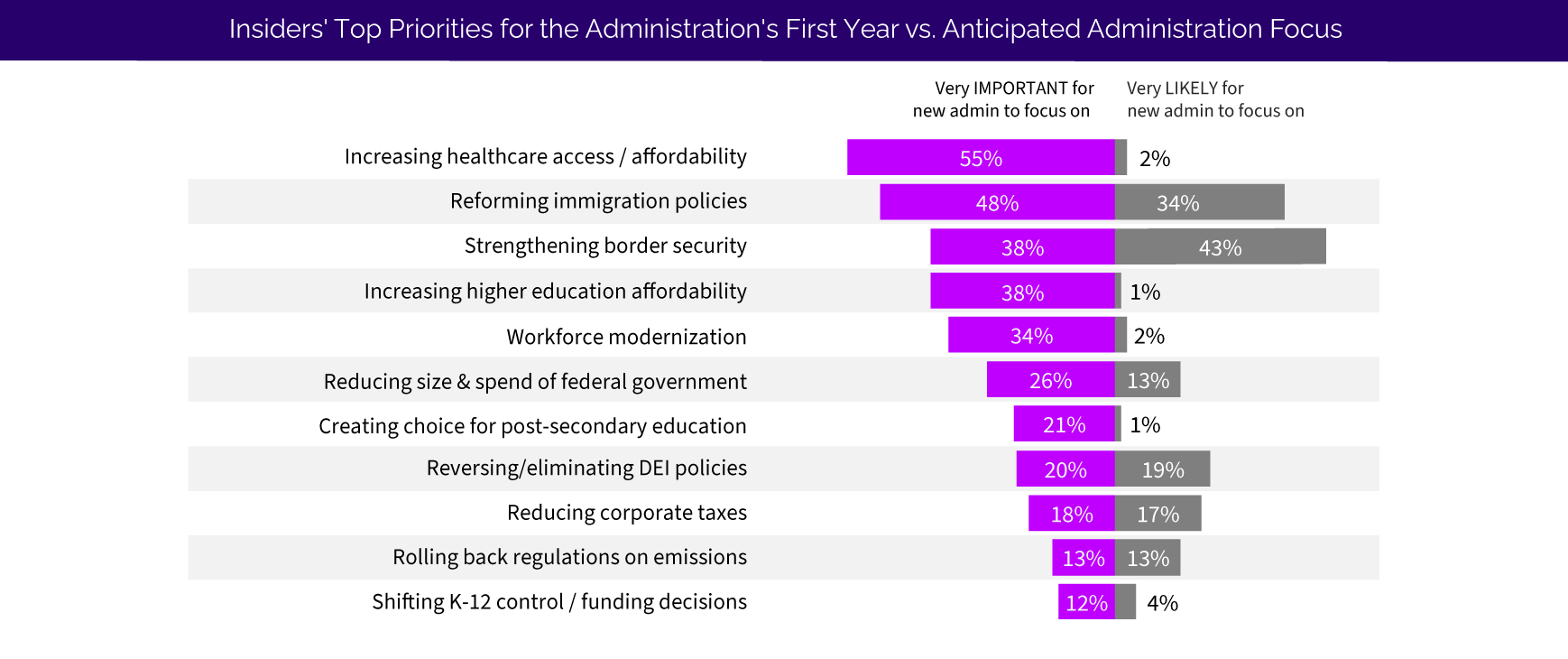
The survey suggests several additional areas where business interests and government priorities may diverge:
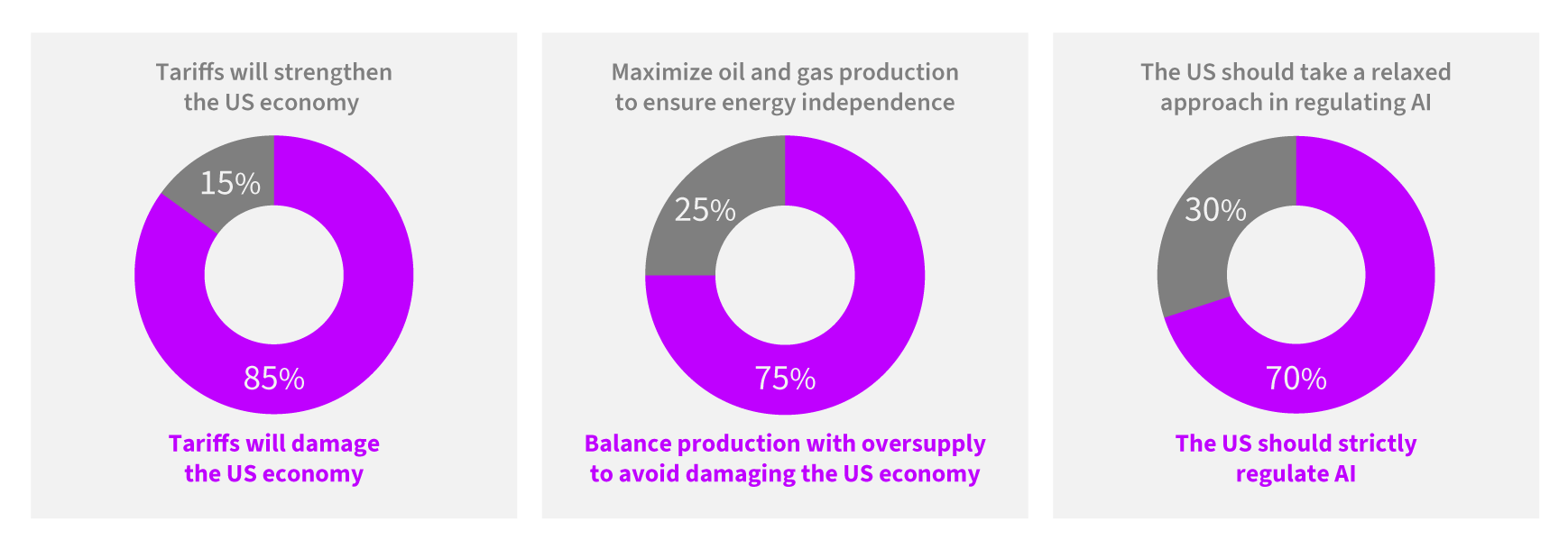
- Trade & Tariffs: Nearly all insiders (85%) agree tariffs would harm the U.S. economy, yet protectionist policies remain a political wildcard.
- Energy Policy: 75% of insiders favor a balanced oil and gas approach rather than maximizing production—potentially clashing with energy sector strategies.
- AI & Tech Regulation: 70% of insiders support stricter AI regulation, even at the expense of U.S. tech companies’ global growth.
What It Means:

The current environment presents both challenges and opportunities for businesses navigating policy shifts, stakeholder expectations, and reputational risks. With federal action uncertain and public scrutiny on the rise, corporate leaders must proactively shape their engagement strategies, balance business needs with regulatory realities, and establish their role as trusted problem-solvers. Here’s what this evolving landscape means for companies:
- People Expect More from Companies: The shifting policy landscape doesn’t just have the potential to create gaps in governance—it is also likely to drive (or renew) expectations around how businesses engage with society. When federal action on key issues is unlikely, the public often looks to companies to help shape solutions—not necessarily by taking stances on divisive political issues, but by clearly communicating their values and demonstrating their contributions in ways that align with stakeholder priorities. The survey highlights areas—for example, workforce modernization, access to affordable education and healthcare, and environmental and social issues—where companies may need to step up their own initiatives and reframe their messaging and engagement strategies to maintain trust and credibility.
- Policy Misalignment Poses Business Risks: The administration’s policy direction—whether on tariffs and trade, energy policy, tech regulation, or DEI—won’t always align with business needs, creating challenges for corporate leaders who must maintain strong relationships with policymakers and regulators while also protecting their firm’s reputation with all stakeholders. This may also mean looking for ways to offer the Trump administration a visible success in one of his priority areas in order to advance your businesses’ broader policy goals.
- Messaging for a Divided Political Climate: In today’s polarized environment, how companies communicate can be just as important as what they communicate. Businesses should ensure their messaging resonates across ideological divides, particularly with MAGA audiences, who may view traditional corporate language as coded for progressive priorities. This doesn’t require changing policy positions but rather framing priorities—like economic growth, innovation, and national competitiveness—in ways that align with values such as patriotism, job creation, and American strength. Additionally, organizations should assess whether certain terms or phrases that previously appealed to left-leaning audiences might now trigger backlash, ensuring that language choices don’t inadvertently alienate key stakeholders or put a target on the company’s reputation.
What To Do About It:

Public Affairs leaders must navigate the tension between policy expectations and business realities. This requires proactive engagement, messaging alignment, and risk mitigation strategies tailored to policymakers, investors, and the public.
- Turn Uncertainty into Competitive Advantage. The current level of political uncertainty naturally breeds hesitation, companies must avoid being paralyzed or focusing solely on risk mitigation. Those that can anticipate change and adapt quickly are best poised to turn disruption into opportunity.
- Navigate Political and Regulatory Tensions. Businesses must manage relationships with policymakers while shaping regulations that balance economic growth with public trust. Advancing their own policy agenda may require aligning with some administration priorities and facilitating transactional wins in key areas of interest. Securing progress on business priorities often depends on ensuring the administration achieves some of its own objectives as well.
- Own the Narrative. Companies that proactively shape conversations, rather than simply reacting to shifting expectations, will build trust with policymakers, investors, and the public. While it is important for businesses to avoid becoming entangled in partisan debates that could alienate stakeholders, they should also recognize that language matters. This requires not just refining messaging but also strategically positioning corporate priorities in ways that resonate across the political spectrum.
- Prepare for Corporate Activism Pressures. Employees, investors, and customers will push companies to fill leadership voids, particularly in areas like workforce training, healthcare benefits, and sustainability.
The companies that lead—by engaging stakeholders, shaping the conversation, and demonstrating impact—will be best positioned to thrive in this evolving environment.
Purple Strategies helps businesses strategically manage corporate reputation, engage stakeholders, and navigate complex policy landscapes. Want to discuss how we can support your team? Let’s connect.
For more content like this, subscribe to the Purple Point newsletter here.
About POLITICO INSIDERS:
The POLITICO Insiders Panel is an invite-only research community that brings together influential decision-makers at the intersection of government, industry, and policy. This panel includes senior leaders from Fortune 100 companies, nonprofits, trade associations, federal agencies, and Congress, providing unique insights into how policymakers and key stakeholders view the evolving political and business landscape. This survey fielded to N=460 people in December 2024 through January 2025.

Posted on
March 4, 2025
5 Min. Read
Author
Purple Strategies
POLITICO & Purple Strategies Post-Election Survey: January 2025
Research Overview
POLITICO and Purple Strategies collaborated to gather insights from the POLITICO Insiders panel on their expectations, perceptions, and priorities related to the post-election political landscape. The research focused on the administration’s potential actions, policy priorities, and the anticipated impact on key issues.
Key Findings
1. Insiders identified immigration reform and border security as the most important and most likely priorities for the new admin’s first year.
- Increasing healthcare access/affordability, higher education affordability, and workforce modernization were also identified as important issues with a low likelihood to get attention in the first year.
2. Opinions regarding TikTok’s future in the U.S. are split, with half of Insiders agreeing it should be banned or forced to sell its operations in the U.S.
3. Three-quarters of Insiders believe domestic oil production should be balanced to avoid oversupply and potential damage to the U.S. economy.
4. Nearly all Insiders agree the use of tariffs would have a negative impact on the U.S. economy.
5. Two-thirds of Insiders support stricter AI regulation, even if it throttles growth of U.S. tech companies globally.
6. Insiders—particularly those in government affairs, nonprofits, and associations—see reforming insurance and addressing PBMs as the most important priorities to lower costs for patients at pharmacies.
[Click here to read more and download the full report]

Posted on
February 19, 2025
6 Min. Read
Author
Purple Strategies
Like Them or Hate Them, Community Notes are Here to Stay
By: Alec Jacobs
Straight to the Point
What we See: The long debate over how to manage misinformation and disinformation on social media is entering a new chapter as companies move away from formal fact-checking and opt instead for user-driven programs like X’s Community Notes.
What It Means: These systems appear to have some promise in terms of their impact and credibility. And though the programs aren’t perfect, the biggest social platforms on the planet seem to be headed in the same direction. It would be wise for companies, especially those uniquely impacted by online misinformation, to recognize where tech companies are going and develop thoughtful and practical strategies to embrace programs like Community Notes.
What to Do About It: Take the time to understand Community Notes and how they work and establish a monitoring and management protocol that is tailored to your business — and the unique challenges you face.
What we See

As the debate continues about the role social media companies can or should play when it comes to correcting or even removing misinformation, it seems many are headed in the direction of replacing official “fact checkers” with democratic, community-based systems where platform users are the ones primarily responsible for correcting false information posted by other users. The leading program of this kind, which we anticipate other platforms will look to emulate, is X’s Community Notes (CNs).
CNs are sourced annotations that appear alongside X posts that contain false information, could be misleading, or could benefit from clarification or additional context. You can read more specifically about how they work at X’s Help Center here but essentially they are written and evaluated by X users who sign up to participate, not by professional fact checkers. CNs that the community agrees are warranted, accurate, well-sourced, and unbiased are attached to the post for all future users to see, and anyone who previously interacted with the post in some way (commented on it, amplified it) are notified that a CN has been attached.
And there are signs that the program could have significant impact on the spread of misinformation:
- Research by X has shown that people are 20 – 40% less likely to believe misleading posts when they are accompanied by a CN compared to posts without one.
- A Cornell study found that adding a CN to an X post reduces the number of retweets by almost half and increases the probability that the author will delete their original post by 80%, limiting the spread of false claims.
What It Means

Though the Community Notes program still has many kinks — and it doesn’t solve every misinformation-related challenge — it and programs like it have the potential to be game-changers for a company’s ability to address misinformation and protect its reputation because CNs:
- are literally attached to the misleading content and deliver notifications to users who previously encountered and engaged with the misinformation. This means companies may not have to spend as much energy, time, and money actively correcting the record with all audiences when a false claim spreads or trying to get them to visit a separate website to “get the facts.”
- can be tied not just to a post but to a piece of media — a video, a misleading image or infographic, etc. — so that the CN is visible whenever the content is shared, even if it’s shared by many different people.
- are seen as more independent and credible than official “fact checkers” by many people, especially those segments of society who have grown to distrust institutions and traditional media outlets.
- are published without named authors, further enhancing their credibility — if a company or their agency writes a CN, its credibility can’t be called into question because of who authored it… because no one will know who did.
For these reasons, we believe all companies — but especially those who are often victims of viral and false social media campaigns — should understand how to use CNs and embrace them as part of their broader strategies aimed at combatting misinformation.
What to Do About It

Now, how do you actually use the program and leverage CNs effectively? Here are some ways to get started:
- Learn more about the mechanics: The CN program is not the most straightforward program — you can’t just sign up today and start writing notes. There’s a complex system of impact scores calculated by how often users accurately rate the CNs of others as “helpful” or “not helpful,” how often they write notes of their own and the degree to which those notes are “helpful” or “not helpful,” and a variety of other factors. The X Help Center linked above has more information about how the program works logistically.
- Sign up for the program: Likely the best way to learn how the program works practically is to have communicators, digital listening analysts, and of course social media team members at your company sign up for CN and start experimenting with it — reading and rating others’ notes to build up their profiles and eventually earn the ability to write CNs of their own.
- Understand what a good CN looks like: Look at others’ CNs that have been approved and attached to posts and start thinking about the notes you’ll write and what the defining features will be — inclusion of reliable, high-quality sources and clear, concise, neutral language that directly addresses the false claim.
- Figure out a monitoring protocol and CN approval process that makes sense for you: Set up social listening tools to capture posts with the most common false claims about your company so you can identify misleading posts and add a note as early as possible.
The Purple team has helped some of the world’s most prominent organizations combat misinformation. If you need support protecting your enterprise value, contact us — we are here to help.
For more content like this, subscribe to the Purple Point newsletter here.

Posted on
February 5, 2025
6 Min. Read
Author
Purple Strategies
Don’t Chase Coverage. Drive Influence.
By: Maddie Wilson & Katie Pudwill
Straight to the Point
What we See: Every pundit with a pulse has churned out a think piece on the 2024 election and what it means for the shifting media landscape and where people actually consume their news. In our new media reality—where there is a deep distrust and lack of interest in traditional, legacy media—strategies that keep earned media in a silo won’t meet your objectives and achieve staying power. News consumers face information overload, curated by algorithms that amplify bias, making it clear that earned media without paid amplification is ineffective. Control over messaging is an illusion; good reporting means telling both sides and even well-crafted stories are subject to sensationalism that can amplify and give voice to critics. In other words, format matters more than the outlet.
What it Means: The days of scattershot PR campaigns are over. Winning in this new landscape requires focus on objectives over channels and rejecting the old notion that success = “being everywhere” or being somewhere that feels important. Precise messaging that is amplified to the right audience repeatedly is the key to breaking through.
What to Do: Be consistent and focus on outcomes. Precision is the key to breaking through the noise.
What We See

PESO is Dead
The 2024 election wasn’t just a political turning point—it was a wake-up call for how dramatically the media landscape has shifted. With as many adults aged 30-49 reporting they got as much as their political news from social media as they did from news websites, it’s safe to say the old media playbook no longer applies. The traditional divide between paid advertising and earned media—the hallmark of the PESO (paid, earned, shared, owned) model—is dead. If you’re not pairing earned media with paid amplification to reach your audiences where they are, you’re missing the mark.
Meanwhile, news consumers are overwhelmed and suffering from information overload. Algorithms and AI curate their feeds, bombarding them with headlines, opinions, and fragmented pieces of information that typically confirm their own biases. By and large, people don’t seek out news anymore—the news finds them. And news isn’t disciplined, fact-checked reporting. It’s polarized, self-selected, and interest-driven.
Here’s what most agencies won’t tell you: earned media can hurt more than it helps. A positive story very rarely moves the needle, but a negative one? Things can spiral out of control before you even have time to measure the impact. True “message control” in earned media engagements—even with a perfect, curated message that tests really, really well—is an illusion.
The question isn’t where your story appears anymore—it’s how. Format beats outlet. Asking where your content will appear is the wrong question. The right question is: what format will resonate with the audience you want to reach? And what format is your CEO, leader, or principal prepared for? Most natural in? Willing to even try? Short formats demand discipline—every word matters. Long formats require relinquishing control, something that often doesn’t come naturally. In Mark Zuckerberg’s’ recent three-hour interview on the Joe Rogan Experience podcast, they discussed how media consumers are more and more hungry for long-form authenticity over short, controlled sound bites. In a sea of noise, depth and authenticity cut through. Real connection to your priority audience thrives in the space beyond the headlines.
What it Means

A Strategic Shift
Achieving a “win” in this new environment means flipping the script: define your objectives first, channels later. Forget the outdated push to “be everywhere.” That’s a stone age PR agency motto, not an effective strategy. Those who successfully break through use precision to reach the right people in the right places using what we know about them, with the necessary frequency to make it stick by repeating a clear, core message across any format you choose. And finding the right audience might require outside-the-box thinking, bold partnerships and new, surprising channels, messages, or platforms to reach audiences where they are today—which could be anywhere.
Coverage doesn’t equal influence. Landing a story in the paper of record might feel like a victory, but if it doesn’t deliver consistent messaging to the right audiences, it’s irrelevant. Influence comes from consistency. Say one thing, say it clearly, and repeat it everywhere that matters. And in this new media environment, the places that matter may not be where your company is accustomed to going.
It’s past time to retire blanket approaches to earned and paid media. Success comes from aligning media efforts with enterprise value—what will drive the business forward? Start and end there. That means rejecting the PR agency status quo: endless “message pillars,” scattershot campaigns, sentiment monitoring and coverage for coverage’s sake. In today’s world, a more focused, precise approach to earned—combined with a strategy to amplify it through paid across multiple channels—delivers more impactful results.
What to Do About it

Action Steps
- Think people, not channels. Stop asking, “What outlet has the largest readership?” Instead, ask, “Who are we trying to reach, and where are they?” Formats matter more than outlets. Target your audience like a political campaign targets swing voters—go where your people are. Do the original audience research to understand what they care about. And do the work to connect what you want to say to what they want to hear.
- Reframe your approach. Coverage for coverage’s sake is pointless, and risky. Focus on outcomes. Chasing big-name media hits may satisfy internal stakeholders, but it won’t drive long-term influence, unless you’re delivering a clear, consistent message—and repeating it until you’re blue in the face.
- Simplify your priorities. Less is more. You can and will have a myriad of business priorities, but each one cannot be the title of your organizations’ story. A chapter, a citation, sure, but know and lead with the title.
- Be bold and focus on the outcome. Most agencies will sell you more: more hits, more channels, more noise. They’re wrong. Hire experts to help you deliver targeted wins with a sharper focus—and amplify them with paid media to ensure your audience sees it and then sees it again.
Influence isn’t about being everywhere—it’s about being effective. Simplify your message, connect it to your audience expectations and repeat it relentlessly. Precision is power. And consistency is how you break through the noise.
The Purple team has helped some of the world’s most well-known brands develop communications strategies to drive influence. If you need support navigating this new media environment, contact us—we are here to help.
For more content like this, subscribe to the Purple Point newsletter here.
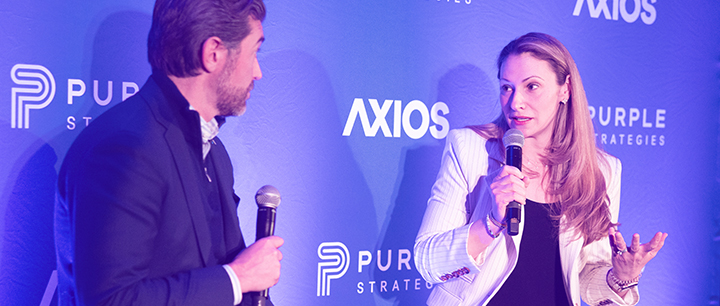
Posted on
January 22, 2025
6 Min. Read
Author
Purple Strategies
Meet the Mindful Majority
Straight to the Point
Last week at the J.P. Morgan Healthcare Conference in San Francisco, Purple Strategies partnered with Axios to host Healthcare in a New Washington. More than 150 senior healthcare leaders joined us for an exclusive conversation on how the industry can navigate trust gaps, public skepticism, and regulatory challenges under a new administration.
The evening featured powerful insights from Kristen Morgante, Managing Partner of Purple Strategies, who shared findings from our new report, Meet the Mindful Majority. Kristen outlined how healthcare companies can adapt to meet the expectations of today’s audiences by embracing trust, transparency, and authentic communication.
As noted during her remarks, gone are the days when “trust the science” was the whole message. Our research shows that in today’s environment, the sentiment triggers distrust, but the science remains essential:
“You need the science—the industry is predicated on it—but you need to balance that with the way people are receiving information and the way you’re communicating.”
The event underscored Purple Strategies’ position as the premier partner for healthcare companies navigating complex reputational and advocacy challenges.
What We See
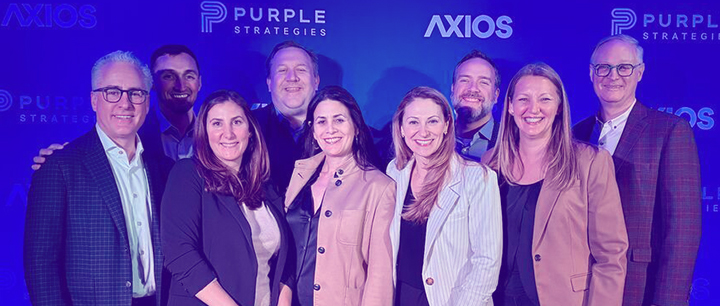
Trust in healthcare is eroding. Public skepticism toward institutions like pharmaceutical companies and regulators has grown, fueled by concerns about transparency and perceived financial motivations:
“Trust is declining for government, for news organizations, and most notably after COVID, for the healthcare industry.”
This skepticism has given rise to what we call the Mindful Majority—a bipartisan coalition of Americans deeply concerned about issues like wellness, ingredient safety, and preventative care:
“This is not a fringe issue. It’s not red, it’s not blue, it’s not germane to a specific demographic. It defies all demographics.”
At the same time, the way people consume information has fundamentally shifted:
“People don’t want to be force-fed information. They want organic, curated information that they’re finding themselves.”
What It Means
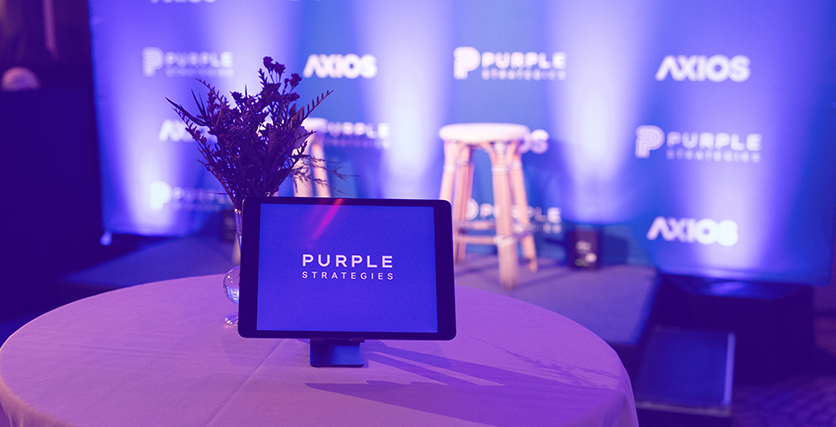
The Mindful Majority is reshaping the healthcare landscape, and their influence is growing. Purple’s research reveals that Americans view the current healthcare system as reactive, focused more on treatment than on wellness. This sentiment demands a rethinking of how healthcare companies engage with the public.
Purple’s findings emphasize the importance of adapting communication strategies to meet these expectations:
“The phrase ‘trust the science’ invites skepticism. Informality lends itself to credibility.”
This shift requires healthcare leaders to balance the rigor of science with authenticity in their messaging. It’s no longer enough to rely on traditional communication channels—companies must embrace informal, transparent platforms to build credibility with today’s audiences.
What to do About It

To navigate these shifts successfully, healthcare leaders need a clear plan of action to address public skepticism, build trust, and communicate authentically. Here’s how:
1. Acknowledge the Trust Gap.
Rebuilding trust starts with recognizing the skepticism many feel toward the industry:
“Acknowledge the trust gap. Companies are going to have to communicate differently and identify credible sources that people will listen to.”
2. Adapt Messaging for Today’s Audience.
Polished, corporate messaging often falls flat with today’s consumers. Recognize the value of informal communication:
“Communicating informally—like on podcasts with self-styled experts—is resonating. More people are seeking that style of information out.”
3. Define Yourself Before Others Do.
The importance of being proactive in shaping your organization’s identity is a lesson drawn from Purple’s political roots:
“One of the hallmarks of political campaigns is define yourself before you’re defined. Be proactive, identify where your weak spots are, and scenario plan for where there may be targets or opportunities.”
Discover More
For a deeper dive into the Purple insights Kristen shared during the event, download our latest report, Meet the Mindful Majority. This report explores how healthcare companies can adapt to the expectations of a changing audience and build lasting trust.
[Click here to download the report]
Stay tuned for more insights from Purple Strategies as we continue to guide healthcare leaders through this rapidly evolving landscape.
For more content like this, subscribe to the Purple Point newsletter here.

Posted on
January 9, 2025
5 Min. Read
Author
Tara Andersen
Strike on Corporate Reputation
Straight to the Point
- WHAT WE SEE: Over the last several years, we have observed an uptick in labor-related challenges — including contentious negotiations, strikes, and organizing elections. Businesses, especially those with large, unionized workforces and vulnerable reputations, have faced increased public pressure and employee activism.
- WHAT IT MEANS: Companies are operating in a new labor environment. Those in high-visibility, complex or highly regulated industries no longer have the luxury of focusing on one issue or topic at a time. Issues are interconnected and the impacts in one area can have spillover effects in many others.
- WHAT TO DO ABOUT IT: Companies must re-evaluate how to approach issues related to organized labor or their workforce. It is important to consider labor wholistically alongside broader issues management and reputation goals.
What We See

After the dramatic, last-minute defeat of President Biden’s renomination of National Labor Relations Board (NLRB) Chair Lauren McFerran in the Senate in December, businesses across the country are perhaps breathing a small sigh of relief. Depending on who President-elect Donald Trump chooses for two open NLRB board seats, the balance of power on the board seems likely to shift away from the decidedly pro-labor approach of the Biden Administration.
But this win for business interests should not be viewed as a bellwether in how union organizing and prominent labor negotiations will proceed during the Trump Administration.
Over the last several years, with some trends starting even prior to the election of President Joe Biden, we have observed an uptick in contentious negotiations, strikes, and organizing elections. Businesses, especially those with large, unionized workforces or vulnerable reputations, have faced increased public pressure and employee activism.
Several factors lead us to believe this labor-related reputation pressure will continue.
- The presidential wildcard. With around 45 percent of union households voting for him, Trump either feels he owes something to organized labor in his new term or believes there is a continued opportunity in to play nice with certain union leaders. Early examples of this dynamic include Trump’s nomination of the Teamster-backed, labor friendly Republican Lori Chavez-DeRemer for Secretary of Labor and his mid-December Truth Social post supporting the East Coast longshoremen over “foreign companies” in the stalled port negotiations.
- Strange political bedfellows. Republicans are no longer reliable allies for corporate America. The same America First populism that strengthened Donald Trump’s victory and that has created strange bedfellows between unions and Republicans like Senators Josh Hawley Marco Rubio and Vice President-elect J.D. Vance on worker issues will continue to make it difficult for companies to count on public support from the right in negotiations and organizing fights.
- Unions are looking for wins. Despite a doubling in union election petitions under President Biden, union membership rates keep falling. Union leaders are looking to reverse this trend and prove their value to members. With public opinion behind them and massive war chests at their disposal, unions – and their allies – will continue to make their case directly to the American people. Savvy union leaders understand what they need to do to drive media coverage, social media attention, and policymaker conversation.
- Left-ward drift by many unions. The labor activist left is seeking wins far beyond the most recent organizing campaign or the bargaining table, making no secret of their desire to remake the American left through union organizing. This loosely affiliated network of individuals and organizations is well-funded with allies across progressive politics who they regularly tap to increase attention and pressure.
What It Means

Corporate reputation and labor relations are intricately linked, with unions applying corporate campaign tactics to other contexts, such as negotiations. As one labor expert observed in a post-election New York Times article, “Unions are very good at destroying reputation.”
Companies in high visibility, complex or highly regulated industries no longer have the luxury of focusing on one issue or topic at a time. Issues are now becoming increasingly interconnected and the impacts in one area can have spillover effects in many others. Companies can’t wait until a negotiation round has kicked off to prepare a communications strategy. Once an organizing effort is underway, it’s often too late to mount an effective reputation defense.
Even if labor policy improves under Trump, companies will still be operating in a new labor environment. One where union bosses are emboldened, the economic fundamentals still give workers leverage, union members aren’t afraid to break with leaders they consider ineffective, and the public largely sees value in and sides with organized labor.
What to do About It

Given these shifts in the labor environment, companies must re-evaluate how to approach issues related to organized labor or their workforce. Depending on the situation, “tried-and-true” tactics and messaging are no longer reliable.
Don’t view labor negotiations as something that happens every four or five years or assume the next organizing effort will fail because the last one did. Instead, consider labor wholistically alongside broader issues management and reputation goals.
To get ahead of future reputation challenges stemming from labor, corporate leaders should:
- Apply a data-driven approach. Know your strengths and weaknesses and use political-style research to understand your key audiences’ beliefs.
- Proactively shape and share your workforce story. Don’t assume that people know how well you pay, the types of benefits you offer, or that the majority of your employees love working for you. And don’t assume others will tell your story for you. The sooner you share a compelling story and educate key audiences with simple, understandable messages, the better.
- Be prepared to run a strong defense, especially in areas where safety, quality and workforce intersect. Unions have become smarter about their messaging. They know that topics such as work-life balance and working conditions can generate more sustained sympathy and support from the public and policymakers. If you are vulnerable in these areas, prepare for attacks.
- Deploy smarter, not necessarily louder, communications.Persuasive messages should be matched to and tailored for key audiences. Discrete deployment of messages and content allows you to reach audiences directly and consistently while reducing the friction that might come from highly visible efforts.
The Purple team has helped some of the world’s most well-known brands manage their reputation through high-profile labor and employee challenges. If you need support in this area, contact us — we are here to help.
For more content like this, subscribe to the Purple Point newsletter here.
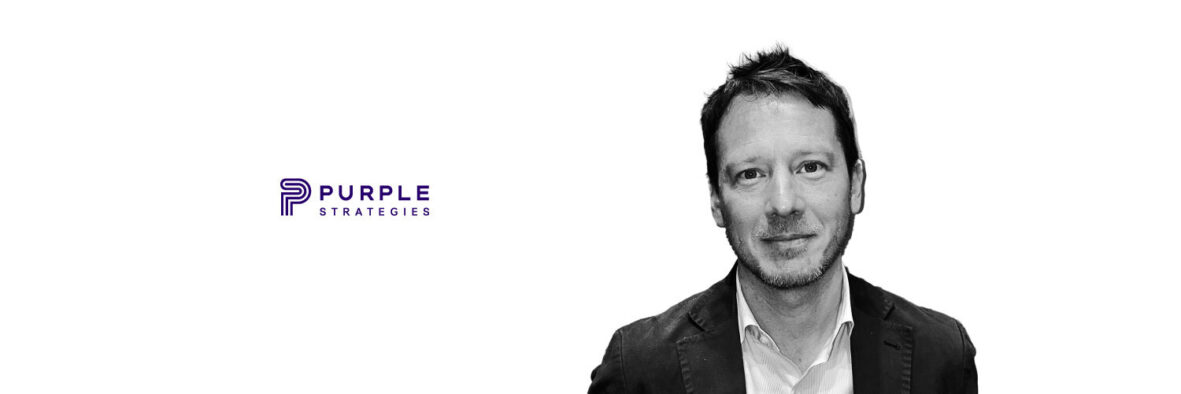
Posted on
December 17, 2024
3 Min. Read
Author
Purple Strategies
Global Insights Leader Jeremy Ruch Joins Purple Strategies
Purple has welcomed veteran reputation, research and insights executive Jeremy Ruch to the firm as a managing director. With more than two decades of experience, Jeremy has guided clients through critical challenges and strengthened connections with stakeholders who matter most, including customers, investors, employees and policymakers.
“In an era marked by rapid transformation and complexity, Jeremy’s deep understanding of global dynamics and ability to turn insights into actionable strategies align with our commitment to help clients build enterprise value through reputation,” said Steve McMahon, Purple co-founder and CEO. “His leadership and perspective will be a tremendous asset to Purple.”
Jeremy has worked with some of the world’s largest companies across industries such as energy, healthcare, tech, retail, media and financial services. Based first in Washington, D.C., and now London, he has supported clients across the U.S., Europe, the Middle East and Africa from the warehouse to the boardroom and from the depths of crisis to the heights of an IPO. Previously, Jeremy was a partner at Brunswick Group, a senior director at FTI Consulting, and a pollster for political, public affairs and corporate clients at Public Opinion Strategies.
He holds degrees in International Relations from the University of Delaware and in Political Management from The George Washington University.
“It’s a real privilege to join a firm that I’ve admired for a long time for its uniquely confident and ambitious approach,” Jeremy said. “From regulatory shifts to geopolitical upheaval to AI, executive teams and boards are confronting an extraordinary volume of change. Bringing in the outside world to validate and pressure-test ideas and decisions is critical, and I’m so glad to be part of this team.”
 Reclaiming Trust When Under Fire
Reclaiming Trust When Under Fire  Reclaiming Trust When Your Products – and Intentions &...
Reclaiming Trust When Your Products – and Intentions &...  Brad Dayspring Joins Purple Strategies as Executive Director
Brad Dayspring Joins Purple Strategies as Executive Director  Celebrating Growth and Leadership at Purple
Celebrating Growth and Leadership at Purple 